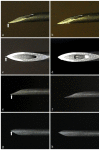Optimal Papanicolaou Smear Conditions for Manual Microdissection of Single Target Cells
- PMID: 38004711
- PMCID: PMC10672744
- DOI: 10.3390/microorganisms11112700
Optimal Papanicolaou Smear Conditions for Manual Microdissection of Single Target Cells
Abstract
This study aimed to investigate the optimal conditions for Papanicolaou (Pap) smear to increase the success rate of target cell isolation through manual microdissection (MMD) and prevent cell spread. Pap smears were prepared using an HPV42-positive SurePath™ liquid-based cytology case, and 46 and 50 koilocytes were used in wet and dried Pap smears, respectively, to verify the success rate of target cell isolation using MMD based on the HPV detection rate. During MMD, the microscopic examination of both specimens revealed that cells in dried smears could be easily identified; however, cell debris remained in the surrounding area after MMD. Although it was difficult to observe cells in wet smears, there was no cell debris. When the needle tip was immersed in DNA lysate after cell isolation through MMD, a difference in cell solubility was found between dry and wet smears. HPV42 was detected in 94.7% and 97.4% of dried and wet Pap smears, respectively, via polymerase chain reaction genotyping using lysed cell solution; the detection rates were not significantly different. The isolation of target cells from wet Pap smears using MMD reduced the risk of contamination and increased the success rate of HPV detection. This study might facilitate the identification of new CIN-derived HPV-infected cells using MMD with wet Pap smears.
Keywords: PCR-based HPV testing; Papanicolaou smear; human papillomavirus; manual microdissection.
Conflict of interest statement
The authors declare no conflict of interest. The funders had no role in the design of the study; in the collection, analyses or interpretation of data; in the writing of the manuscript; or in the decision to publish the results.
Figures


References
-
- Wright T.C., Stoler M.H., Behrens C.M., Sharma A., Zhang G., Wright T.L. Primary cervical cancer screening with human papillomavirus: End of study results from the ATHENA study using HPV as the first-line screening test. Gynecol. Oncol. 2015;136:189–197. doi: 10.1016/j.ygyno.2014.11.076. - DOI - PubMed
-
- Saslow D., Solomon D., Lawson H.W., Killackey M., Kulasingam S.L., Cain J., Garcia F.A.R., Moriarty A.T., Waxman A.G., Wilbur D.C., et al. American Society for Colposcopy and Cervical Pathology, and American Society for Clinical Pathology screening guidelines for the prevention and early detection of cervical cancer. CA Cancer J. Clin. 2012;137:516–542. doi: 10.1309/AJCPTGD94EVRSJCG. - DOI - PubMed
Grants and funding
LinkOut - more resources
Full Text Sources
Research Materials

